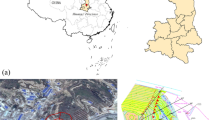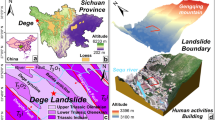Abstract
Loess environments such as the Chinese Loess Plateau are geologically fragile because of their great thickness, loose structure, crisscrossing ravines and gullies, broken terrain, dry climate, severe erosion and unevenly distributed rainfall. As a consequence, loess areas are highly prone to environmental problems and geological hazards. The geological structure of the loess is one of the main factors that controls occurrence of these geohazards. This study investigated the mechanism of loess landslides and their sliding control mode from the perspective of their geological structure. Using this mechanism, a three-dimensional geological model of loess landslides was established. The study shows that the structural planes in loess divide a complete slope into separate blocks, which enables the fast and deep infiltration of surface water via seepage channels and reduces the shear strength of the soil mass, inducing landslides. The development and formation of loess landslides are primarily controlled by structural planes and influenced by infiltrated water softening the structural plains. Various types of structural planes may combine and form structural bodies of different types and scales, which control the type, depth and scale of loess landslides.









Similar content being viewed by others
References
Cui S, Pei X, WU H, Huang R (2018) Centrifuge model test of an irrigation-induced loess landslide in the Heifangtai loess platform, Northwest China. J Mt Sci 15(1):130–143. https://doi.org/10.1007/s11629-017-4490-0
Fan X, Xu Q, Scaringi G, Li S, Peng D (2017) A chemo-mechanical insight into the failure mechanism of frequently occurred landslides in the Loess Plateau, Gansu Province, China. Eng Geol 228:337–345. https://doi.org/10.1016/j.enggeo.2017.09.003
Leng Y, Peng J, Wang Q, Meng Z, Huang W (2018) A fluidized landslide occurred in the Loess Plateau: a study on loess landslide in South Jingyang tableland. Eng Geol 236:129–136. https://doi.org/10.1016/j.enggeo.2017.05.006
Li P (2016) Groundwater quality in Western China: challenges and paths forward for groundwater quality research in Western China. Expo Health 8(3):305–310. https://doi.org/10.1007/s12403-016-0210-1
Li P (2018) Mine water problems and solutions in China. Mine Water Environ 37(2):217–221. https://doi.org/10.1007/s10230-018-0543-z
Li P, Qian H (2018a) Water in loess. In: Meyers R (ed) Encyclopedia of sustainability science and technology. Springer, New York, pp 1–17. https://doi.org/10.1007/978-1-4939-2493-6_968-1
Li P, Qian H (2018b) Water resources research to support a sustainable China. Int J Water Resour Dev 34(3):327–336. https://doi.org/10.1080/07900627.2018.1452723
Li P, Qian H, Wu J (2014) Accelerate research on land creation. Nature 510(7503):29–31. https://doi.org/10.1038/510029a
Li P, Qian H, Howard KWF, Wu J (2015a) Building a new and sustainable “Silk Road economic belt”. Environ Earth Sci 74(10):7267–7270. https://doi.org/10.1007/s12665-015-4739-2
Li B, Feng Z, Wang WP (2015b) Characteristics of the Sanmen Formation clays and their relationship with loess landslides in the Guanzhong area, Shaanxi, China. Arabian Journal of Geosciences 8(10):7831–7843. https://doi.org/10.1007/s12517-015-1822-7
Li P, Feng W, Xue C, Tian R, Wang S (2017a) Spatiotemporal variability of contaminants in lake water and their risks to human health: a case study of the Shahu Lake Tourist Area, Northwest China. Exposure Health 9(3):213–225. https://doi.org/10.1007/s12403-016-0237-3
Li P, Tian R, Xue C, Wu J (2017b) Progress, opportunities, and key fields for groundwater quality research under the impacts of human activities in China with a special focus on western China. Environ Sci Pollut Res 24(15):13224–13234. https://doi.org/10.1007/s11356-017-8753-7
Li P, He X, Li Y, Xiang G (2018a) Occurrence and health implication of fluoride in groundwater of loess aquifer in the Chinese Loess Plateau: a case study of Tongchuan, Northwest China. Exposure Health. https://doi.org/10.1007/s12403-018-0278-x
Li P, Qian H, Wu J (2018b) Conjunctive use of groundwater and surface water to reduce soil salinization in the Yinchuan Plain, North-West China. Int J Water Resour Dev 34(3):337–353. https://doi.org/10.1080/07900627.2018.1443059
Li P, Wu J, Tian R, He S, He X, Xue C, Zhang K (2018c) Geochemistry, hydraulic connectivity and quality appraisal of multilayered groundwater in the Hongdunzi Coal Mine, Northwest China. Mine Water Environ 37(2):222–237. https://doi.org/10.1007/s10230-017-0507-8
Luo H, Wu F, Chang J, Xu J (2018) Microstructural constraints on geotechnical properties of Malan Loess: a case study from Zhaojiaan landslide in Shaanxi province, China. Eng Geol 236:60–69. https://doi.org/10.1016/j.enggeo.2017.11.002
Pan D (1958) Loess. Geological Press, Beijing (in Chinese)
Peng J, Fan Z, Wu D, Zhuang J, Dai F, Chen W, Zhao C (2015) Heavy rainfall triggered loess–mudstone landslide and subsequent debris flow in Tianshui, china. Eng Geol 186(24):79–90. https://doi.org/10.1016/j.enggeo.2014.08.015
Peng J, Leng Y, Zhu X, Wu D, Tong X (2016) Development of a loess-mudstone landslide in a fault fracture zone. Environ Earth Sci 75(8):658–671. https://doi.org/10.1007/s12665-016-5336-8
Peng J, Ma P, Wang Q, Zhu X, Zhang F, Tong X, Huang W (2018a) Interaction between landsliding materials and the underlying erodible bed in a loess flowslide. Eng Geol 234:38–49. https://doi.org/10.1016/j.enggeo.2018.01.001
Peng J, Sun P, Igwe O, Li X (2018b) Loess caves, a special kind of geo-hazard on loess plateau, northwestern China. Eng Geol 236:79–88. https://doi.org/10.1016/j.enggeo.2017.08.012
Qiu H, Cui P, Hu S, Regmi AD, Wang X, Yang D (2018) Developing empirical relationships to predict loess slide travel distances: a case study on the Loess Plateau in China. Bull Eng Geol Environ (1):1–11. https://doi.org/10.1007/s10064-018-1328-0
Richthofen B (1882) On the mode of origin of the Loess. Geol Mag 9(7):293–305. https://doi.org/10.1017/S001675680017164X
Song B, Chen W, Wu W, Jiang Y (2012) Experimental study of large scale direct shear test of sliding zone soil of Suoertou landslide with different moisture contents. Rock Soil Mech (s2):77–84. (in Chinese)
Sun J (1988) Environmental geology in loess areas of China. Environ Geol Water Sci 12(1):49–61. https://doi.org/10.1007/BF02574827
Tu X, Kwong A, Dai F, Tham L, Min H (2009) Field monitoring of rainfall infiltration in a loess slope and analysis of failure mechanism of rainfall-induced landslides. Eng Geol 105(1–2):134–150. https://doi.org/10.1016/j.enggeo.2008.11.011
Tu X, Dai F, Kwong AKL, Tham LG, Xu L (2010) Causes of recurring landslides in Loess Plateau, Shaanxi Province, China. Hkie Trans 17(1):36–44. https://doi.org/10.1080/1023697X.2010.10668186
Wang Y (1990) Structure and physical and mechanical properties of Chinese loess. Science Press, Beijing (in Chinese)
Wang G, Zhang D, Furuya G, Yang J (2014a) Pore-pressure generation and fluidization in a loess landslide triggered by the 1920 Haiyuan earthquake, China: A case study. Eng Geol 174(1):36–45. https://doi.org/10.1016/j.enggeo.2014.03.006
Wang J, Liang Y, Zhang H, Wu Y, Lin X (2014b) A loess landslide induced by excavation and rainfall. Landslides 11(1):141–152. https://doi.org/10.1007/s10346-013-0418-0
Wang G, Li T, Xing X, Zhou Y (2015) Research on loess flow-slides induced by rainfall in July 2013 in Yan’an, NW China. Environ Earth Sci 73(12):7933–7944. https://doi.org/10.1007/s12665-014-3951-9
Wu Y (2003) Mechanism analysis of hazards caused by the interaction between groundwater and geo-environment. Environ Geol 44(7):811–819. https://doi.org/10.1007/s00254-003-0819-9
Wu W, Su X, Liu W, Wei W, Feng L, Yang T (2014) Loess mudstone interface landslides: Characteristics and causes. J Glaciol Geocryol 36(5):1167–1175 (in Chinese)
Xu L, Dai F, Gong Q, Min H (2012a) Irrigation-induced loess flow failure in Heifangtai Platform, North-West China. Environ Earth Sci 66(6):1707–1713. https://doi.org/10.1007/s12665-011-0950-y
Xu L, Qiao X, Wu C, Iqbal J, Dai F (2012b) Causes of landslide recurrence in a loess platform with respect to hydrological processes. Nat Hazards 64(2):1657–1670. https://doi.org/10.1007/s11069-012-0326-y
Xu L, Dai F, Tu X, Javed I, Woodard M, Jin Y, Tham L (2013) Occurrence of landsliding on slopes where flowsliding had previously occurred: An investigation in a loess platform, North-west China. Catena 104(5):195–209. https://doi.org/10.1016/j.catena.2012.11.010
Xu X, Guo W, Liu Y, Ma J, Wen L, Hong W, Hang G (2017) Landslides on the Loess Plateau of China: a latest statistics together with a close look. Nat Hazards 86(3):1393–1403. https://doi.org/10.1007/s11069-016-2738-6
Xu L, Coop M, Zhang M, Wang G (2018) The mechanics of a saturated silty loess and implications for landslides. Eng Geol 236:29–42. https://doi.org/10.1016/j.enggeo.2017.02.021
Zeng R, Meng X, Zhang F, Wang S, Cui Z, Zhang M (2016) Characterizing hydrological processes on loess slopes using electrical resistivity tomography-a case study of the Heifangtai Terrace, Northwest China. J Hydrol 541:742–753. https://doi.org/10.1016/j.jhydrol.2016.07.033
Zhang M, Liu J (2010) Controlling factors of loess landslides in western China. Environ Earth Sci 59(8):1671–1680. https://doi.org/10.1007/s12665-009-0149-7
Zhang D, Wang G (2007) Study of the 1920 Haiyuan earthquake-induced landslides in loess (China). Eng Geol 94(1–2):76–88. https://doi.org/10.1016/j.enggeo.2007.07.007
Zhou J, Zhu C, Zheng J, Wang X, Liu Z (2002) Landslide disaster in the loess area of China. J Forest Res 13(2):157–161. https://doi.org/10.1007/BF02857244
Zhou Z, Li B, Wang Z (2007) Critical sliding forecast for loess-rock landslide at Wen chang ge, Lanzhou. J Lanzhou Univ (Natural Sciences) 43(1):11–14 (in Chinese)
Zhuang JQ, Peng JB (2014) A coupled slope cutting-a prolonged rainfall-induced loess landslide: a 17 October 2011 case study. Bull Eng Geol Environ 73(4):997–1011. https://doi.org/10.1007/s10064-014-0645-1
Acknowledgements
The authors express their gratitude to the anonymous reviewers and editors for their thoughtful comments and suggestions to improve this paper. This study was financially supported by the National Basic Research Program of China (No. 2014CB744703).
Author information
Authors and Affiliations
Corresponding author
Additional information
This article is a part of a Topical Collection in Environmental Earth Sciences on Water resources development and protection in loess areas of the world, edited by Drs. Peiyue Li and Hui Qian.
Rights and permissions
About this article
Cite this article
Peng, J., Tong, X., Wang, S. et al. Three-dimensional geological structures and sliding factors and modes of loess landslides. Environ Earth Sci 77, 675 (2018). https://doi.org/10.1007/s12665-018-7863-y
Received:
Accepted:
Published:
DOI: https://doi.org/10.1007/s12665-018-7863-y




